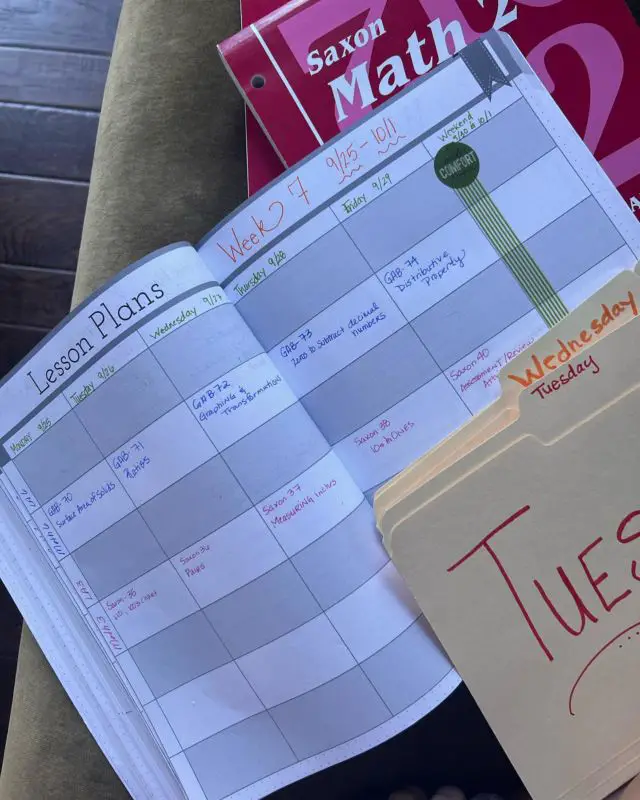 I’ve been using Saxon Math for almost as long as I’ve been homeschooling…(16 years). It’s my staple, no-brainer curriculum choice year after year. For whatever reason–talk of math curriculum brings out some really strong emotions among the homeschool crowd. We’re fierce about our math! Perhaps because math is such a foundational subject or perhaps because we all carry a little bit of our own baggage about the subject–we want to get math right for our kids. Today I’m pouring out everything I know about Saxon Math:
I’ve been using Saxon Math for almost as long as I’ve been homeschooling…(16 years). It’s my staple, no-brainer curriculum choice year after year. For whatever reason–talk of math curriculum brings out some really strong emotions among the homeschool crowd. We’re fierce about our math! Perhaps because math is such a foundational subject or perhaps because we all carry a little bit of our own baggage about the subject–we want to get math right for our kids. Today I’m pouring out everything I know about Saxon Math:
- What it is (We’ll look at all grade level options)
- Pros vs. Cons
- How you can adapt it for your kids
- Options you have to get some extra help with teaching it!
**Whew…this post is a long one! Scroll through to find what you need and be sure to pin it for later!**
What is Saxon Math?
Saxon Math was created by John Saxon over 30 years ago and was eventually sold to Harcourt (now Houghton Mifflin Hartcourt). His desire was to create a math curriculum that builds a strong foundation in skills with an emphasis on review. The curriculum is used in public, private, and homeschools around the world (and includes phonics & spelling programs). For our purposes–we’ll just focus on their homeschool math programs.
When people talk about Saxon Math they often refer to it as a spiral method. So what the heck does that mean?
In the spiral method, math topics are introduced in small pieces. The concepts are built upon very gradually. The next step to expand upon a skill might not be introduced for several days (if not weeks) later.
For example: One day your child might learn about money (let’s say a specific coin–the quarter). The next day it’s fractions. Then you might cover some multiplication…Eventually it wraps back around to a new lesson about money (such as new coin or counting a combination of coins).
Each lesson has opportunities to practice the new skill. But most of the independent work revolves around review of previously taught material.
For example: A lesson may have 30 problems–5 may be practice over the new skill and 25 will review material from previous lessons. Practice problems can be combinations of time, money, words problems, measurement, graphs, multiplication, fractions, and addition facts--anything and everything your child has previously covered.
Saxon Math K-3:
The Saxon Math homeschool program for kindergarten through 3rd grade has a unique format, completely separate from the rest of the Saxon Math Program. The lessons are scripted and designed to be open and go. In addition, Math manipulatives are frequently incorporated–which I love.
Each level includes a spiral-bound teacher’s manual and meeting book. (That completes the Math K Home Study Kit.) Home Study Kits for Levels 1, 2, & 3 also include student workbooks and flash cards.
Because I already own all the teacher manuals–I just purchase the student workbooks for my younger children. I skip the meeting book–it’s basically a calendar with counting, graphing, and weather. We have a separate large calendar that I prefer to use–so I find that the meeting book is redundant and something I tend to skip over anyway.
But if you’re just starting out–buying the complete homeschool kit is usually the most cost-effective way to purchase the curriculum!
You will definitely need math manipulatives with any of the Saxon K-3 programs...these are purchased separately from the homeschool kits. Saxon sells a math manipulative kit to keep it simple…But you can also purchase pieces individually.
Not included with the manipulative kits are base-ten blocks…I personally think these are a must-have for teaching place-value and adding or subtracting 2 & 3 digit numbers.
**A Note About Saxon K:
If your child has previous preschool math experience–they may be ready for Saxon Math 1.
(Here’s a handy scope-and-sequence chart to see what skills are covered!)
Saxon Math Intermediate Grade 3:
In recent years, Saxon has made their public school line of math curriculum available to homeschool families. This line is known as Saxon Intermediate (Grades 3-5). The Intermediate books do not have teacher manuals–but instead are hardcover student textbooks. They’re written to the student and follow a similar format to traditional Saxon upper-elementary and middle school math programs (we’ll get to that in a just a bit).
I prefer the hands-on, interactive approach for grade 3 (so I use Saxon Math 3)–but if you’re transitioning from the public school system, I think Saxon Math Intermediate 3 is a great choice! (In addition–the Intermediate series aligns with Common Core Standards found in public schools.)
Saxon Math for Grades 4-5:
Traditionally, after Saxon Math 3, homeschool students begin Saxon Math 5/4 followed by Saxon Math 6/5.
**You will notice the upper elementary and middle school Saxon levels are written in this weird fractional format (though it’s not pronounced as a fraction–just Saxon Math 5, 4)…The first number is the average student grade level and the second number is the advanced student grade level for which the book is intended. So Math 5/4 is perfect for average-level 5th grade math students or advanced-level 4th grade students.
There is a huge change in format from the Saxon K-3 program! At this level, there is no longer a spiral-scripted teacher manual.
Instead these homeschool kits include:
- Student Edition Text (These are soft-cover, with newsprint-like pages. My kids wrote in them like workbooks.)
- Tests & Worksheets
- Solutions Manual
The Student Texts are written to the student–but I always either read them first or read the lesson with my kids.
The lessons have warm-ups (which we often skipped) and the new learning is short (maybe 15-20 minutes). A small amount of practice problems are focused on the new learning. (We always worked these together.) Then the main assignment is about 30 problems of mixed practice (problems from previous lessons–with a few from the new lesson tossed in).
I rarely had my kids do all the problems...You can get more ideas to adapt the lessons below!
Intermediate Math Grade 4 & 5:
As I mentioned above with Intermediate Math Grade 3…Saxon offers their public school line of math curriculum to homeschool families for 4th and 5th grade.
I have NOT personally used any of the Intermediate products (but I have readers who use and love them).
In my research, here’s what stands out as the biggest differences in using the Intermediate series vs. the traditional Saxon Math 5/4 or 6/5:
- Intermediate includes a hardcover textbook
- Aligns with Common Core
- Less Teacher Intensive
- More Problem Solving
Saxon Math for Grades 6-12:
Middle School…Let the fun begin, Momma!
The traditional path for Saxon Math in the Middle School Grades looks like this (especially for those who have used Saxon throughout the elementary years):
- 6th Grade: Math 7/6
- 7th Grade: Math 8/7
- 8th Grade: Algebra 1/2 OR Algebra 1
Or if you started Saxon a bit later or took a slower pace (which is perfectly fine), it might also look like this:
It’s important to note that Algebra 1/2 is very much a review of Math 8/7–both are considered pre-algebra. If your child is grasping Math 8/7 with little difficulty–then you should just proceed to Algebra 1. If your kiddo is struggling through Math 8/7–then go with Algebra 1/2.
High School…You Made It!
My experience with Saxon Math ends with their “Classic” Algebra 2. My oldest 2 children finished their high school education at our local public high school (Saxon more than prepared them). And my homeschooled 16 year old loves Teaching Textbooks for high school math.
Be aware–Saxon has 2 different tracks (or editions) for high school!
- The Classic (3rd Edition): Algebra 1, Algebra 2, Advanced Math (similar to pre-calculus), Calculus
- 4th Edition + Geometry: Algebra 1, Algebra 2, Geometry, Advanced Math, Calculus
Cathy Duffy has the very best, detailed information and reviews about using Saxon for your high school student! She is my trusted source for the nitty-gritty details!
I can say with certainty that if you are using Saxon Math for high school math–your child will have a very thorough understanding of mathematics!
However–I found it difficult to keep up and teach the lessons as we entered Algebra 2. If I was using Saxon again for anything beyond Math 8/7–I would utilize videos to teach the lessons. (You can use video teachers much earlier–which makes a lot of sense if you personally don’t have the time or desire to teach the lessons! More about video options below!)
Overall Pros vs. Cons of Saxon Math:
1st the Good News…The Positive
The spiral method is great if you like your math in small chunks!
Don’t worry if there were math tears over telling time to 5 minutes, because tomorrow we’re moving on to picture graphs…
The spiral method prevents kids from getting stuck in a difficult or frustrating concept. They get just a little taste of it to push them a little further along–but tomorrow is a new day!
I find that stepping away from a concept for a few days can be really helpful…The new ideas have time to soak in and get practiced–and when it’s time to add onto the skill, my kids are usually ready.
I also appreciate that the majority of the practice problems cover skills my kids have already learned–reinforcing and reviewing skills, while also building confidence!
In addition, I have found Saxon to be very thorough. I love how big concepts are broken down into bite-sized pieces–and I think the way they teach math skills is genius…
However…The Not-So-Good
The spiral method can be a discombobulated mess for some kids!
Your child may learn better by focusing on a unit that thoroughly covers a single math concept. This is the way I personally remember learning when I was in school…We would do a unit on fractions or multiplication or telling time…
**However–then I would sometimes forget how to do skills from previous units…**
If your child needs more time diving deep into a skill–Saxon might be frustrating. Or your child may just find it too jarring–all the jumping from skill to skill found in Saxon.
Ultimately–that’s what happened with my 16 year-old daughter. We used Saxon until Pre-Algebra and then switched her to Teaching Textbooks. She is much, much happier.
Even for my kids that are especially math-minded…We had lots of math tears with Saxon. (But the one who cried the most math tears went on to get a big engineering scholarship and is majoring in Civil Engineering…She’s currently getting an A in Calculus 2. Her math foundation is firmly rooted in Saxon Math.)
The final complaint I hear a lot of moms make when talking about Saxon is the length…Lessons can get long and the practice can get even longer…
Which leads to my next point…
How to Make Saxon Math Work for You
The lesson can get very lengthy…IF you do it all.
So please, please–feel free to cut, skip, or change the lessons to meet your needs!!
I rarely do the Meeting/Warm-Up part of Saxon lessons…Kids only have so much attention and by the time I get through the warm-up, we’ve reached that limit! So most days I just skip it or just talk about one piece of review!
I look at the objective and if I think there’s a better way to teach it–such as using manipulatives—I change the lesson and do it my way!
If we’ve practiced the objective enough with games and/or hands-on activities–I skip the assignment all together!
We do not do all the math fact sheets!!
Sometimes with little kids--we do the worksheet orally.
As my kids advanced in Saxon, often the assignments took more time..Here are some ways I shortened assignments:
- Do just the evens or the odds.
- I pick 5 problems for my kids and they pick 5 problems.
- Do the first 15 problems or the last 15 problems.
And remember–just because your curriculum provides tests, doesn’t mean you have to use the assessments on their schedule! I often found the testing to be excessive with Saxon and so we would skip some of the tests. Make it work for you!
Resources to Help Teach Saxon Math
I mentioned above in the high school section, that if I were teaching upper level Saxon Math–I would definitely utilize a video teaching aid! I know this would have made my life a lot easier! Here are 3 popular options to explore:
Saxon Teacher (Created by Saxon for level 5/4 and up)
If you have younger kids–and you’d like some ideas about how to use math manipulatives, here’s a link to my YouTube video:
A Saxon Loyalist…BUT
There is a lot to love about Saxon–but it’s not for every child or family. It is incredibly thorough. But its spiral approach is jumpy–and you might prefer a curriculum that tackles math concepts with a unit approach.
I also find it very “mommy-intensive,”–I really had to keep up with it, actively teach it, and help my kids through Saxon Math. In contrast, I’ve found Teaching Textbooks to be a great way for my older daughter to do math independently.
For now–Saxon is my choice for the elementary years (especially the K-3 program). But I would definitely consider it again for upper grades if my kiddo was successful with the spiral method or particularly gifted in mathematics (and I used video support)!
Sending you Happy Math Thoughts and Wishing You No Math Tears!
With Love,
Jen xo





